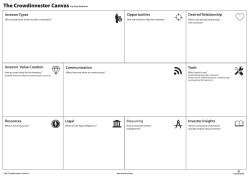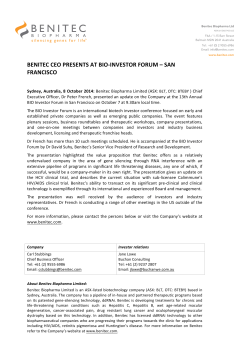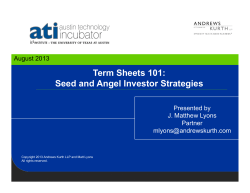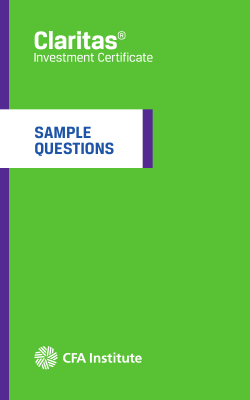
CAPITAL RAISING BUSINESS PLAN Preparing a
Preparing a CAPITAL RAISING BUSINESS PLAN CONTENTS A. INTRODUCTION 3 B. INDICATIVE TIMETABLE C. THE BUSINESS PLAN PROCESS 4 5 D. BUSINESS PLAN STRUCTURE & CONTENTS 6 Corporate Directory 1. Executive Summary Opportunity Company Market Investment 2. Background & Opportunity 3. Market Profile 4. Products & Intellectual Property 5. Marketing & Distribution Strategy 6. Structure & Resources 7. Financial Information 8. The Investment 9. Attachments 7 7 7 7 8 9 10 11 12 12 13 13 Financial Details 13 13 Shareholding Details 13 Organisation Charts 13 13 Industry Statistics Product Brochures & Company Profiles Directors Backgrounds Client Lists Financial Details—Suggested Format E. OTHER ISSUES Funding Options Action Plan 2 6 7 13 13 14 15 15 15 A. INTRODUCTION Targeting investors with a Capital Raising Business Plan that focuses on revenue and profit growth with minimum risk. This Guide aims to assist Howitt & Co clients, and prospective clients, to prepare and present a capital raising business plan. Fundamentally, this plan is a promotional document that presents essential information to potential investors about the business opportunity that requires funding. When assessing a business idea’s investment potential, most investors focus on revenue and profit growth with minimum risk. The Business Plan should clearly highlight any structural elements or strategies that will enable investors to realise these aims. The complete document should be no more than ten pages long, plus attachments. The plan should provide sufficient summary information for investors to assess whether the opportunity is of initial interest. A savvy investor will then pursue further research in more detail. Howitt & Co advisers have both the expertise and real-world experience to prepare and present high quality business plans to investors. Using our successful methodologies, we can help add real value to business opportunities, presenting each business case in a way that makes investors sit up and take notice. Use this complementary guide as the starting point to preparing your Business Plan. Our advisers will be happy to provide you with more detailed advice and assistance, if required. Call Richard on 0411 888 842 or email us at richard@howittco.com to discuss your needs. The Howitt & Co Guide to Preparing a Capital Raising Business Plan has been developed to help entrepreneurs present a strong business case to potential investors. Howitt & Co expert advisers can help you crystallise the value in your business opportunity and target the right investors to ensure your business venture succeeds. 3 B. INDICATIVE TIMETABLE Before embarking on a capital-raising project, it helps to become familiar with each task in the project and its anticipated time frame. This indicative chart outlines the entire capital raising process. Preparing the Capital Raising Business Plan and supporting documentation is crucial to this process. It is important to shape the business plan to reflect the current investment marketplace and ensure the investment opportunity has the right market profile, products, structure and resources to gain the interest of the investment community. It can take up to four weeks just to get the Business Plan right, so plan early. TASKS –16 –15 –14 –13 –12 –11 –10 –9 –8 –7 –6 –5 –4 –3 –2 –1 0 WEEK RESPONSE 1. Sign mandate Client 2. Prepare Capital Raising Business Plan & presentation material Client/L&A 3. Assess funding alternatives L&A 4. Marketing of opportunity L&A/Client 5. Hold initial discussion with potential investors L&A 6. Undertake detailed investigation Investor/Client 7. Undertake valuation & due diligence Investor/L&A 8. Conduct negotiations Investor/Client/L&A 9. Document Heads of Agreement L&A/Client/Investor 10. Develop funding documentation Investor/Client/L&A 11. Sign agreements & transfer funds Investor/Client/L&A 4 C. THE BUSINESS PLAN PROCESS Business planning is a process of thinking strategically about the future of your business. It takes into account both external and internal factors that may affect the business or alter its strategic direction in the future. The business plan is divided into eight key sections, which are outlined in the chart below. Collating the information required for each section and moulding this into a clear and logical format is a lengthy process. Initially, your company’s relevant senior personnel can draft each section. You can then pull the information into a tight, workable document once the each section draft is completed. The Executive Summary is written last, and takes the key points from each section to form a compelling summary of the business case, and your financial requirements. Business Plan Process 1. EXECUTIVE SUMMARY 2. BACKGROUND & OPPORTUNITY • • • • • Mission Company History Shareholding Key Strengths Competitive Advantage 3. MARKET PROFILE • • • • • Market Stats Competitors Trends Customers Positioning 4. PRODUCTS & IP • Intellectual Property • Patents • Technologies • Products/Services • Future Directions 5. MARKETING & DISTRIBUTION • Sales and Marketing Plan • Advertising and Promotion • Distribution • Differentiation 6. STRUCTURE & RESOURCES • Organisational Structure • Locations • Key Personnel • Joint Ventures & Strategic Alliances 9. ATTACHMENTS 5 7. FINANCIAL INFORMATION • • • • • Profit and Loss Balance Sheet Projections Cash Flows Risk Analysis 8. INVESTMENT • • • • • Purpose Equity ROI Timing Exit Plan D. BUSINESS PLAN STRUCTURE & CONTENTS D. BUSINESS PLAN STRUCTURE & CONTENTS To compile your business plan, work through each of the sections outlined below, supplying relevant documentation and information. The worksheets for each section follow a question and answer format. The questions aim to focus your efforts and direct you to the essential information needed to complete each section. Once you have covered each of the questions raised, you can start to pull the complete plan together into a more concise format. Keep in mind that the finished plan will be 8-10 pages long. One of the most important sections is the Executive Summary, which is usually the first page that potential investors will read. The Executive Summary should state the key points of your business case, and answers ‘why would I want to invest in this business opportunity?’ The Business Plan is essentially a promotional tool for your organisation, so make sure you keep your writing clear, concise and to the point. Corporate Directory This is a single page at the start or end of the plan that documents essential contact information including: • key company contacts • directors • share registry • registered office • advisers (accountants, solicitors, stockbrokers, bankers, consultants). Make sure the information you provide in this section is up to date. Have any details changed since you began the capital-raising project? 6 D. BUSINESS PLAN STRUCTURE & CONTENTS D. BUSINESS PLAN STRUCTURE & CONTENTS 1. Executive Summary The Executive Summary is written after all other sections are completed. Each of the sections should be briefly summarised in one or two paragraphs, emphasising the essential rationale of the investment opportunity. Keep the information clear and compelling and aim to limit this section to one page. Opportunity This section provides a descriptive summary of the opportunity and gives the reader a feel for the product and market. It addresses: • What is the opportunity? • Why does it exist and what is special about the product or service? • What is wrong with the current way of doing things? • What is the solution and its advantage? The remaining sections of the Executive Summary provide a simple overview of the business plan’s latter sections. Company • Provide a brief background about the company. • Describe the product or service offered and its competitive advantage. • What is the investment in the product and company to date? • What are the relevant management and technical skills that exist in the company? Market • Describe the market for the product or service. • What is its size and growth potential? • Briefly comment on the marketing program. • Describe the market drivers that make this an attractive sector to address. Investment 7 • What is the required investment? • What do the investors receive for the investment? • Quantify the anticipated returns. • What action is required to achieve this? D. BUSINESS PLAN STRUCTURE & CONTENTS 2. Background & Opportunity This section describes the essential business opportunity and should give the investor an outline of the company, its products and the market. It should be several paragraphs in length. 8 • Give a brief summary of the company, its activities and the products or services that it supplies. • Provide a statement about the company and its objectives, the regard with which it is held in the local and international market place and its prospects. • Describe the business opportunity - products, technology, market niche, investment size and the time horizon. • Elaborate on the past successes that the Company has achieved and also provide available references. • What have the major strategies been up to now? • Elaborate on the success or failure of these strategies. • What are the current strategies and their expected results? • What is the financial potential of the company if the business opportunity is taken up? • What are the key strengths of the company? • What is the company’s sustainable competitive advantage? • Are there other resources apart from financial resources that will be important in taking the company forward? Describe. • What investment is required? When? • What is the central business rationale? D. BUSINESS PLAN STRUCTURE & CONTENTS 3. Market Profile This section should give details about the actual market and the relative position of the company and its products in the marketplace. 9 • What is the size and growth rate of the market? • If the company has a number of operating divisions or subsidiaries, provide an analysis of the market and the products segmented into these groups. • Comment on the market, the size and the particular niche that the company’s products address. Provide figures to support the anticipated growth rates for the market segments. • How are the products distributed? • Where do the company and its products stand in the market place and who are its major competitors? • State the needs of the market place, the future direction and how the company will address the issues in the foreseeable future. • What impacts will the rapidly changing environment have on the market place and will this provide opportunities or threats? Is there any new or replacement technology that can be foreseen? • What joint ventures or alliances are in place to facilitate the development and marketing of products both within Australia and internationally? Elaborate on any commercial relationships, including any with customers or suppliers. • Describe the customer base and provide sales statistics on the top 10 customers. • Are there any special features or characteristics that will provide significant opportunities? • What valuable components are in place in the company such as methodologies, processes, intellectual property, patents, licences or commercial agreements/alliances? • What are the ‘barriers to entry’ of the market place? D. BUSINESS PLAN STRUCTURE & CONTENTS 4. Products & Intellectual Property This section should cover the benefits of the products and the value attributed to the intellectual property. 1 • Summarise each of the products or technologies and state the benefits of each. • Describe the proprietary technology/products that have been developed or acquired by the company. • Explain why they are significant, what benefits they provide and how they are related to the market. • State why the proprietary technology and/or products give the company significant competitive advantage. • Do the technologies have the potential for further development? • Provide a positioning statement of where the technologies place the company relative to the market and competition. • Document any patents or other valuable intellectual property. • What capabilities does the company have for undertaking further research & development? D. BUSINESS PLAN STRUCTURE & CONTENTS 5. Marketing & Distribution Strategy The focus of this section is to give the investor confidence that there is a well thought out marketing plan that will successfully launch the product. This section includes information on key product attributes, the pricing policy and promotional and distribution strategies. 1 • Provide a brief summary of the Marketing Plan. (This summary can be written after you complete this section). • What are the key product attributes to be marketed? • What are the special features - why does it work well? • How is it different to the competition? • How does price compare with competitive products? • How is any price premium justified? • How sustainable is a cut-price product? • What are the marketing skills of the people? • What is their experience in handling advertising agencies? • What is their experience in advertising and promotion? • How will products be brought to market? • What are the special features of the distribution strategy? • Outline the efficiencies in the strategy. • What is the market positioning and differentiation? • Explain the strengths of the distribution strategy. • How is technology applied to achieve maximum efficiency in distribution? D. BUSINESS PLAN STRUCTURE & CONTENTS 6. Structure & Resources This section should document an outline of the company, its people and the structure of its functional areas. • Explain the Corporate Structure (including an organisational chart) • What are the major characteristics of the management team? • What is the size and structure of the company? (This includes offices, people, associates, product lines, etc). • Provide a brief resume (one to two paragraphs) of each member of the Board of Directors. • Provide backgrounds of key staff members and their contractual relationships. • What is the structure of the shareholding of the company? • Describe the major strategic alliances and joint ventures. • Explain how the management approach is sustainable. 7. Financial Information The financial section should provide summary details for profit and loss and balance sheet items. The table on page 14 can be used as a template for information to provide. 1 • Provide summary Profit and Loss statements for the last five years and forecasts for the next five years by product, group or division, if applicable. • Provide the last balance sheet and a pro forma balance sheet reflecting the post investment scenario. • What financial resources are currently in place? • Provide explanations to support the revenue and profit figures. • Elaborate on any major expenditure items and the anticipated benefits. • Are any special funding initiatives in place (Government export grants, assistance, etc)? • What impact will the equity injection have? • What are the major risks in relation to the investment including: 1. Economic risks 2. Industry specific risks 3. Company specific risks 4. Business risks 5. Other factors 6. Provide a sensitivity analysis of the projections. D. BUSINESS PLAN STRUCTURE & CONTENTS 8. The Investment This key section should briefly summarise what capital or investment is required and the benefits for the investor. This is your opportunity to secure their interest, so keep the investor’s needs in mind when writing this section. 9. • Explain the need for the capital injection. • How much is required and when? • Provide cash flow projections with a timetable for the required investment and likely returns. • State the benefits of the investment for the company and for the investor. • Explain the equity share proposed for the investor. • Describe the programs that the capital will fund. • Quantify the expected return on investment. • Specify the term of the investment and the possible exit strategies for the investor. Attachments The attachments listed are intended to provide the investor with background information that will assist in the decision making process. Industry Statistics Provide any relevant statistics about the industry and market place in which the company operates, particularly regarding major trends and areas of growth. Estimates of market share of the major competitors would also be useful. Financial Details See the suggested template on page 14. Shareholding Details Provide a list of shareholders, the number of shares, types of shares and % holding. Organisation Charts Provide charts that show clearly the companies involved in the structure and also the key roles and individuals in the main operating entity. Product Brochures and Company Profiles Include relevant brochures, promotional documents and news cuttings about the company. Directors Backgrounds Provide brief background notes on each of the Directors. Client Lists List major and well-known clients. 1 D. BUSINESS PLAN STRUCTURE & CONTENTS Financial Details - Suggested Format INNOVATIVE COMPANY Profit & Loss Statement for Year Ended 30 June 200_ (A$’000) Last FY Sales Revenue Annual Revenue Growth (%) Gross profit EBIT Interest Tax NPAT NPAT/Rev (%) Rev/Employee Balance Sheet as of 30 June 20___ (A$’000) Current Assets Cash & Other Receivables Inventories Total Current Assets Non Current Assets Plant & Equipment Intellectual Property Goodwill Total Non Current Assets TOTAL ASSETS Current Liabilities Bank Debt Trade Creditors Sundry Creditors & Accruals Lease & Hire Purchase Total Current Liabilities Non current liabilities Other Loans Bank Debt Provisions Lease & Hire Purchase Total Non Current Liabilities TOTAL LIABILITIES SHAREHOLDERS’ FUNDS DEBT/EQUITY RATIO 1 Current FY Current FY+1 Current FY+2 E. OTHER ISSUES Funding Options Several debt and equity-based funding options are available to companies, each with some strong advantages and disadvantages. • Private Equity • High Net Worth • Private Equity Funding • Venture Capital • Public Equity • Grants The different options impact on a number of important areas, and each of these needs to be considered in detail before making a final decision on the most appropriate funding method for your business venture. Areas to consider include: • Capital Gains Tax Implications • Board Representation • Exit Mechanisms for Investors • Dividends vs. Capital Growth Policy • Independent Valuations • Staff Agreements and Incentives • Share Options • Performance Options Action Plan Finally, you will also need to provide a detailed plan of the immediate actions required for the investor to participate in the investment opportunity. This should preferably be in a Gantt chart form describing clear responsibilities and timetable. An example of such a chart is shown in Section B: Indicative Investment Timetable, on page 4 of this guide. 1
© Copyright 2025





















